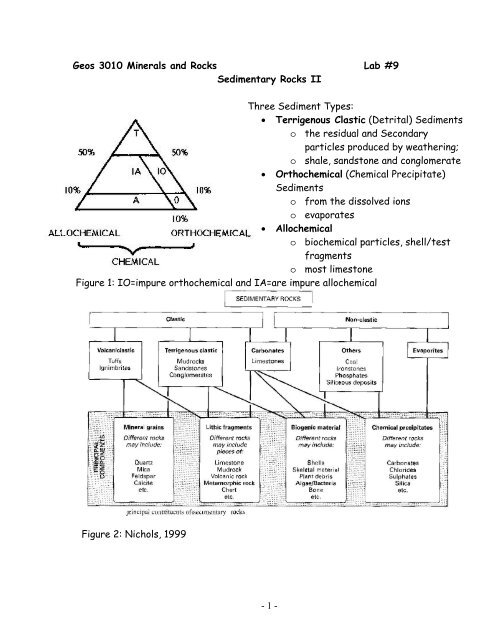Sedimentary Rocks II
Sedimentary Rocks II
Sedimentary Rocks II
Create successful ePaper yourself
Turn your PDF publications into a flip-book with our unique Google optimized e-Paper software.
Geos 3010 Minerals and <strong>Rocks</strong> Lab #9<br />
<strong>Sedimentary</strong> <strong>Rocks</strong> <strong>II</strong><br />
Three Sediment Types:<br />
• Terrigenous Clastic (Detrital) Sediments<br />
o the residual and Secondary<br />
particles produced by weathering;<br />
o shale, sandstone and conglomerate<br />
• Orthochemical (Chemical Precipitate)<br />
Sediments<br />
o from the dissolved ions<br />
o evaporates<br />
• Allochemical<br />
o biochemical particles, shell/test<br />
fragments<br />
o most limestone<br />
Figure 1: IO=impure orthochemical and IA=are impure allochemical<br />
Figure 2: Nichols, 1999<br />
- 1 -
Lithology of Mudrocks<br />
The term “Mud” refers to all clastic particles less than 63: (0.063mm). This<br />
includes both silt and clay size particles. Because these particles are far too small to<br />
identify mineralogically textural properties are the criteria for classification<br />
For unconsolidated, mud-rich sediment the terms “Silt”, “Mud”, and “Clay” are<br />
used in accordance with the relative proportions shown in Figure 3. The best method<br />
for determining the relative proportions of silt versus clay is the “taste test”. Yea,<br />
take a bite. If you “crunch” grains, they are probably silt.<br />
The term fissile is defined as a strong planar fabric. When it is parallel to<br />
bedding it is called laminated. This texture is a product of the flat and parallel<br />
alignment of clay size particles (phyllosilicate minerals are the most common “clay<br />
size” particles). Siltstone is not commonly fissile.<br />
Figure 3<br />
Lithology of Gravel and Conglomerate<br />
Terrigenous clastic sediments and rocks consisting of >30% gravel and larger<br />
size particles are referred to as gravels (disaggragated), conglomerates (rock),<br />
breccias (rock), and diamictite (rock).<br />
1. Conglomerate: Sub- to well-rounded, clast-supported (clasts touch one another)<br />
2. Breccia: Angular, clast supported<br />
3. Diamictite: matrix supported (gravel clasts not touching), rounded or angular<br />
- 2 -
Lithology of Sand and Sandstone<br />
The classification of sandstone on the bases of mineral content requires an<br />
estimate of normalized Quartz, Feldspar, and Rock Fragments. These normalized<br />
proportions are plotted on a ternary diagram (Figure 4) and a rock name is<br />
determined. Sub-quartzose sandstone (
Lithology of Limestone<br />
Limestone is a rock whose origin is much less obvious than sandstone,<br />
mudstone and conglomerate (for those of us who live in temperate latitudes)! The<br />
most common, particulate, sand-sized, calcareous sediment forms in shallow, warm,<br />
tropical, marine waters in the absence of terrigenous sand, mud, and gravel. The<br />
most common Carbonate Allochemical Sediment types consists of (1) Fossil<br />
Fragments, although there are other common carbonate allochems in carbonate<br />
depositional environments:<br />
(2) Pellets (mostly fecal particles), (3) Ooids (concretionary carbonate like hail<br />
stones), and particles of lithified carbonate called (4) Lithoclasts.<br />
The equivalent of “mud” in the world of carbonate sediments is “carbonate mud”<br />
or Micrite, very fine-grained micr ocrystallite s of carbonate formed by some algae,<br />
through abrasion of allochems, and rarely through direct precipitation. The presence<br />
of “carbonate mud” indicates low current energy in the warm shallow, marine waters in<br />
which the carbonate sediment accumulates.<br />
The ratio of mud to grains is the main criteria for the Dunham Limestone<br />
Classification Scheme (Figure5). Additional considerations in naming limestones<br />
includes: original organic binding (like reefs), or complete absence of primary<br />
depositional textures. Dunham limestone names should include a principle allochem<br />
grain type, such as “fossiliferous packstone or “pelletal wackestone”.<br />
Figure 5<br />
- 4 -
The composition of allochemical grains and the texture are used in another limestone<br />
classification scheme formulated by Folk.<br />
Figure 6: Folk Limestone Classification<br />
- 5 -
Chemical Sediments; Evaporate Deposits<br />
IONS IN SEA WATER (in ppm)<br />
Note that most of the dissolved material consists of Na and Cl i.e. - "salt"<br />
Cl- 18,980 K+ 380<br />
Na+ 10,556 HCO3 - 140<br />
SO4 = 2,649 Br 65<br />
Mg++ 1,272 H3BO3 - 26<br />
Ca++ 400 Sr++ 8<br />
USIGLIO'S EXPERIMENT<br />
An experiment where by sea water was evaporated in order to determine the<br />
sequence of salts precipitated. The sequence of precipitation is as follows.<br />
1. CaCO3 4. MgSO4<br />
2. CaSO4 2H2O - CaSO4 5. MgCl2<br />
3. NaCl 6. K-Mg Salts<br />
SOME EVAPORITE MINERALS<br />
Marine<br />
Gypsum-anhydrite<br />
Halite<br />
Polyhalite<br />
Carnallite<br />
Terrestrial<br />
Soda<br />
Trona<br />
Glauber Salt<br />
Borax<br />
MAJOR EVAPORITE AREAS AND GEOLOGIC PERIODS<br />
Michigan, Ohio, New York - Silurian<br />
Michigan - Mississippian Permian Basin<br />
Texas - Permian<br />
Zechstein Germany - Permian<br />
Paradox Basin, Utah - Pennsylvanian<br />
Williston Basin, N. Dakota - Devonian<br />
Gulf Coast US (Salt Domes) – Mesozoic<br />
East Coast US - Triassic Rift Basin<br />
- 6 -

















